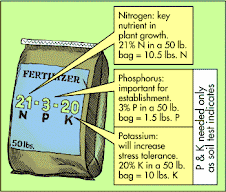 Fertilizers: If you plan to fertilize once a year, make it in the fall. Cool weather grasses like tall fescue and Kentucky bluegrass are the most frequent lawns grown in Kentucky. These grasses grow best in the fall, especially their roots. Fertilizing at this time builds the root base to prepare the grass for the hot summer months. You can still fertilize in December if you missed in the earlier fall.
Fertilizers: If you plan to fertilize once a year, make it in the fall. Cool weather grasses like tall fescue and Kentucky bluegrass are the most frequent lawns grown in Kentucky. These grasses grow best in the fall, especially their roots. Fertilizing at this time builds the root base to prepare the grass for the hot summer months. You can still fertilize in December if you missed in the earlier fall.Fertilizers contain three main nutrients, Nitrogen (N), Phosphorus (P), and Potassium (K). Once applied, phosphorus and potassium remain in the soil for several years. Nitrogen washes out. These nutrients are expressed in ratios on fertilizer packaging, to represent N-P-K. A ratio of 10-10-10 in a 30lb. bag of fertilizer means 10 pounds of nitrogen (N), 10 pounds of phosphate (P) and 10 pounds of potash (K). The fertilizer is called ‘balanced’ when the three numbers are equal. When a proper level of P and K is reached in the soil, little additional P or K may be needed for several years.

A new lawn will need a balanced fertilizer. An established lawn will need a fertilizer higher in nitrogen. Regular fertilizing helps prevent weeds. “Weed and Feed’ fertilizers contain herbicides as well. Those containing crabgrass and other grassy weed killers should be applied in mid-April to mid-May. Broadleaf herbicides can be applied in fall and spring.
If you have not had your soil tested before, take two pints of randomly gathered soil to the Extension Office (Rowan County Courthouse or Carter County Courthouse for these two counties). For a few dollars you can get a soil profile that tells you if your soil needs phosphorus (P), potassium (K) or lime. The acidity level of your soil is also analyzed. Based on the Extension recommendation you can apply the needed nutrient to your lawn. You will also add nitrogen. If you are familiar with farming fertilizers, these are cheaper. However they are harder to apply, more apt to burn a lawn and are not formulated to pop right into your spreader. Use these only if you truly know how to use farm fertilizers.
Mowing: Mow often, mow high and keep the blade sharp. Cutting grass too short is the most common damage done to grass. Grass grows more in spring and fall and needs more mowing at those times than in the heat of summer. Kentucky bluegrass should be mowed 2 to 2 ½ inches high. Tall Fescue and Creeping Red Fescue should be mowed 2 to 3 inches high. Mowing shorter than these heights restricts root development, and grasses become easily diseased, or heat and drought damaged, not to mention more easily infested with weeds. Here is a general rule to follow: Mow often enough so that no more than 1/3 to ½ of the grass leafage is removed at any one time. If the grass grows too tall, raise the mowing height, and mow again in a few days. Don’t mow it all at once. You will damage your grass.




